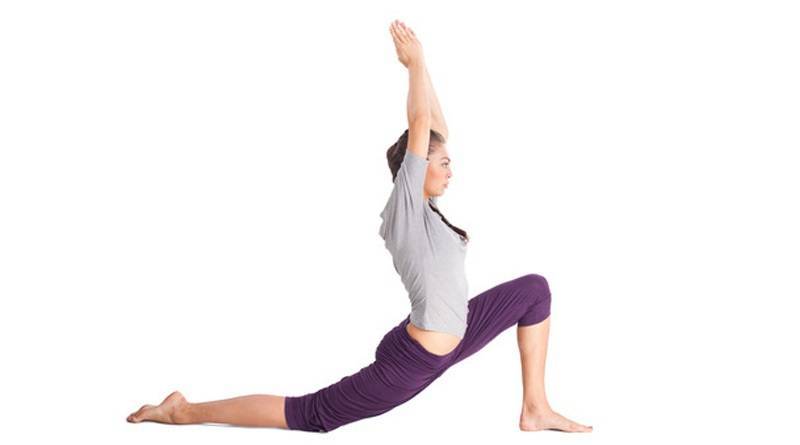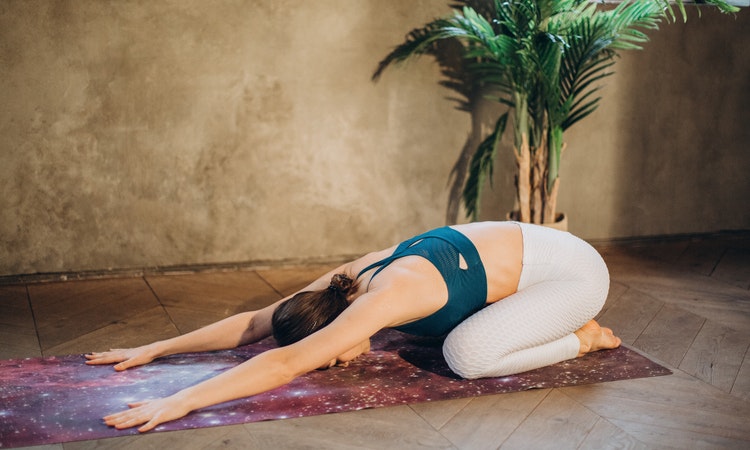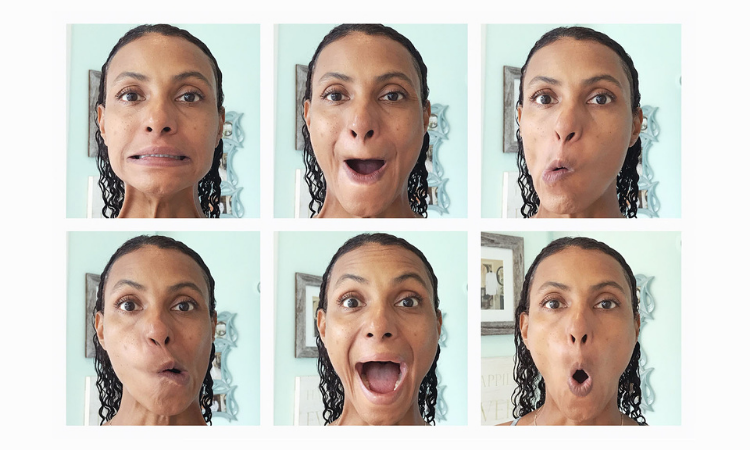It strengthens your core. It makes your body agile. It aligns your body with your mind and soul.
But contrary to what many might think, yoga can aid your weight loss journey beautifully. While it detoxifies your body, yoga makes you a mindful eater and helps prevent stress eating. Your brain is more aware of what you consume and what your body needs. Yoga brings down the levels of the stress hormone, Cortisol, the rise of which is associated with fat storage in areas we want the least, like the stomach. To top it all, many core asanas spark your metabolism and aid calorie burning.
Ashtanga, Vinyasa, and Power Yoga are ideal for shedding those extra kilos and make perfect accompaniments to your cardio and weight training routine. Here, we list out the postures to incorporate in your routine, which will help you to best embrace yoga for weight loss.
1. Paripurna Navasana (Boat Pose)
Sit on your mat with your legs straight in front of you. Keep your hand a little behind your hip, fingers pointing forward. Press them and straighten the arm. Lift the top of your breastbone and lean back slightly, continuing to lengthen the front of your torso between the pubis and top of your breastbone. Make sure not to round your back.
Exhale, bend your knee, and slowly lift your feet, to make an angle of 45 degrees with your thighs, relative to the floor. As you lengthen your tailbone, lift your pubis towards your navel. Try to straighten your knees with the tip of your toes slightly above your eye-level.
Stretch your arms parallel to each other and the floor. Spread your shoulder blades and reach out through your fingers.
Anchor the pose by pressing the heads of the thigh bones toward the floor, lifting the top of your breastbone. Remember to keep the lower belly flat. Breathe easily. Tilt the chin slightly toward your breastbone so the base of the skull lifts lightly away from the back of the neck.
Stay in the pose initially for 10-20 seconds and gradually increase the time of your stay to 1 minute. Bring the legs back while you exhale, sit upright, and inhale.
The pose strengthens your abs and deep hip flexor, aids digestion, and relieves stress.

2. Virabhadrasana II (Warrior Pose II)
Begin in Tadasana (Mountain Pose). Inhale and lift your arms over your head, then bring your hands into prayer position at your chest. Step your feet 4-5 ft apart, while raising your arms parallel to the floor, palms facing down. Reach out to the sides, drawing your shoulder blades apart.
Turn your right foot slightly to the right and your left foot out to the left 90 degrees, aligning the right and the left heel. Firm your thighs and turn your left thigh outward so that the centre of the left knee cap is in line with the centre of the left ankle.
Exhale, bend your left knee so as to make the shin perpendicular to the floor. Bring your left thigh parallel to the floor, if possible. Press the outer heel firmly to the floor and hold this movement.
Stretch arms keeping them parallel to the floor. Make sure not to lean the torso over left thigh and keep the sides equally long and shoulders directly over the pelvis. Press the tailbone slightly towards the pubis, turn the head to the left and look out over the fingers.
Hold posture for several long, deep breaths (30 seconds to 1 minute). Inhale as you come up, then repeat with your other leg forward.
Aptly named after the fierce warrior, this asana builds stamina and endurance, strengthens your legs and ankles, and opens your chest and shoulders.

3. Utthita Parsvakonasana ( Extended Side Angle Pose)
From Warrior II pose (with right knee bent), bring the right elbow down to the right knee, inhale and move the left arm up, towards the ceiling. Exhale, and take the arm over the ear, making a straight line with the left side of your body.
While the right knee is bent directly over the ankle, sink the hips down towards the floor, and reach the left fingers away from the left foot.
Breathe and hold for 3-6 breaths.
Inhale and reach the left fingers up and back into Warrior II or straighten the legs coming into 5 pointed star.
Repeat on other side.
This asana strengthens and stretches the legs, knees, and ankles. It stretches the groin, spine, waist, chest and lungs, and shoulders.

4. Adho Mukha Svanasana (Downward Dog)
Stand on all four limbs in a table-top position. Place your knees directly below hips and keep the hands slightly forward off the shoulders. Your palms spread, your index fingers should be parallel or slightly turned out.
Lift your knees off the floor as you exhale. Keep the knees slightly bent initially and your heels lifted away from the mat. Press your tailbone lightly towards the pelvis as you lengthen it away from the back of the pelvis. Draw your inner legs up into the groin.
Exhale and push the top of the thighs back and stretch the heels towards the floor. Keep the knee straight and take care that they aren’t locked. Keeping the outer thigh firm, move the upper thigh slightly inward and narrow the front of the pelvis.
Press the bases of the index fingers into the floor and lift along the inner arms from the wrists to the top of the shoulders. Draw your shoulder blades down the back, then widen and continue to draw your shoulders toward the tailbone. Keep your head between your upper arms.
Hold the pose anywhere between 1 to 3 minutes.
Release the pose by bending the knees to the floor on an exhalation and rest in Child’s Pose.
An advanced alteration is to increase the stretch by lifting your body and pulling your hips such that they are higher.
This common foundation pose stretches, tones, and lengthens the entire spinal column. It strengthens and tones the arms, shoulders, back muscles, abdominals, hips, and thighs. Make sure that your bowels and stomach are empty before you perform this asana.

5. Anjaneyasana (Lunge Pose)
Taking from the Adho Mukha Svanasana, exhale and step forward with your right foot between your hands, aligning the right knee over the heel.
Keeping the right knee fixed in place, lower your left knee to the floor and slide the left back until you feel a stretch in the front of your left thigh and your groin area. Turn the top of your left foot to the floor.
Inhale and lift your torso upright. While you do this, extend your arms to the sides and up, keeping them perpendicular to the floor. Draw the tailbone towards the floor and lift up your pubic bone, towards your navel. Lift up your chest against the back torso.
Move your head back and look up. Reach your pinkie toes towards the ceiling.
Hold for 60 seconds, exhale your torso back to the right thigh and your hands to the floor, and turn your back toes under. Exhale again, lift your left knee off the floor, and step back to Adho Mukha Svanasana.
Repeat with the other foot forward and keep the same duration of the asana.
The low lunge pose gives the hamstrings, groin, quadriceps, and hips a good stretch, and it also allows a full range of motion in the lower body.

6. Vasisthasana (Side Plank)
Begin again in the downward dog pose. Lower your hips and come forward into a plank pose (like the top of a push up – flat palms, extended body with the legs reaching through your heels).
Get your feet together and press your weight down through your right hand and forearm. Move your body to the right, balancing on the outer edge of your right foot. Your left foot will be stacked on top of your right foot and your legs will be a straight line.
Beginners can lower their right knee and shin to the floor and keep their hips lifted, while building strength in the arms and torso.
Extend your left arm to the ceiling, reaching through your fingertips as you lift your hips and firm the triceps of both arms. You will feel the muscles across your shoulder blades flex. Firm your thighs, and press through your heels into the mat. Bring your body into one straight line. Look at your top thumb and press down through your bottom index finger.
Hold for up to 30 seconds. Exhale as you slowly return to Plank Pose, then into Downward-Facing Dog. Repeat on the other side and rest in Child’s Pose thereafter.
This asana strengthens the abdomen, legs, and arms.

Get your calories burning without even hitting the treadmill and enjoy benefits that go much beyond weight loss.

 Web Stories
Web Stories











